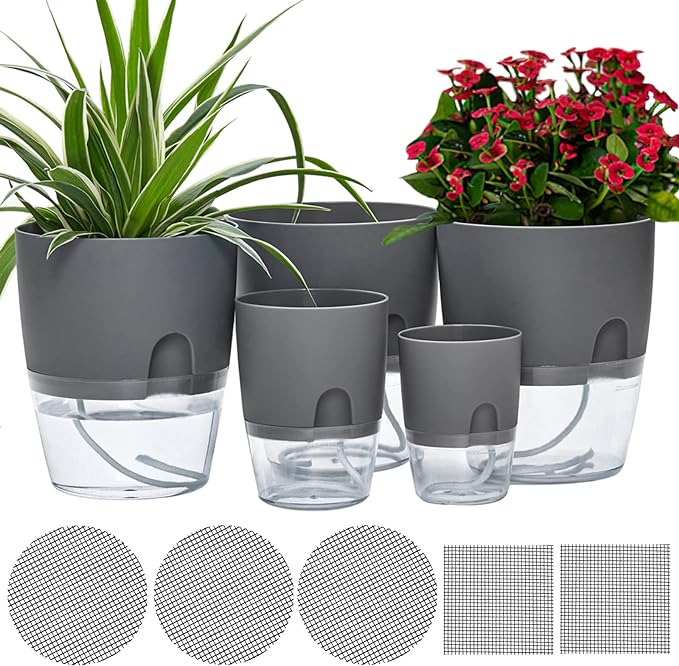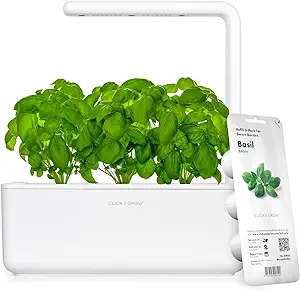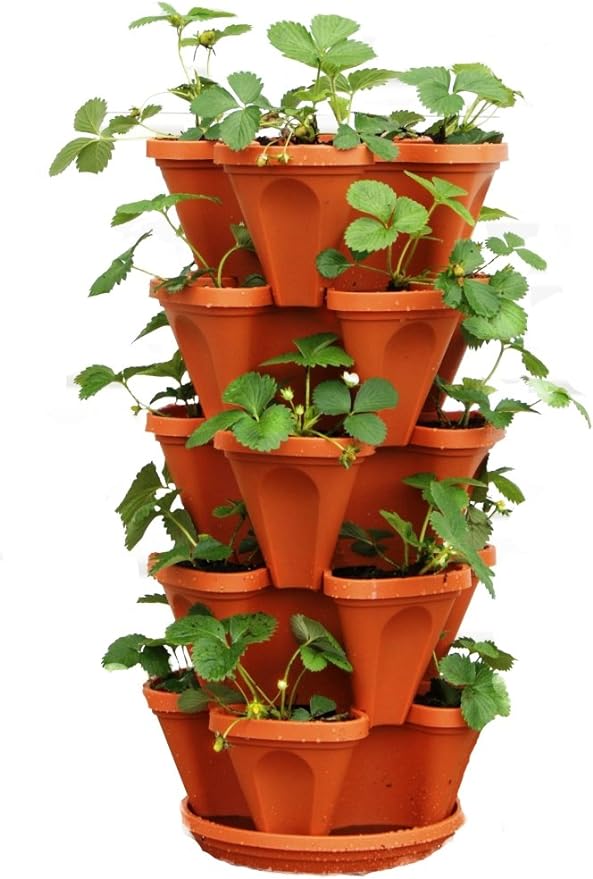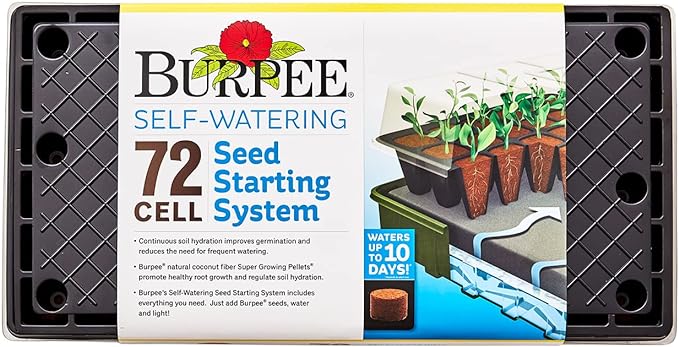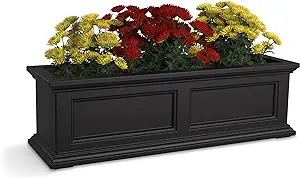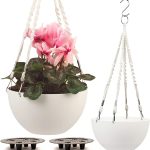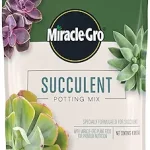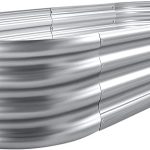As you explore the world of self-watering planters, you’ll discover a range of innovative solutions designed to make plant care a breeze. From compact designs perfect for small spaces to feature-rich systems that promote healthy root growth, the options are vast. But with so many choices, it can be overwhelming to find the right fit for your plants. That’s why we’ve narrowed down the search to the top 6 self-watering planters on the market, each offering unique benefits that’ll take your plant parenting skills to the next level. But which one will reign supreme?
Contents
- 6 Pack Self Watering Planter Pots for Indoor Outdoor Gardens
- Click & Grow Indoor Herb Garden Kit
- Mr. Stacky TC-1 Planter, Terra Cotta
- Burpee Self-Watering Seed Starter Tray, 72 Cells
- Mayne Fairfield 3ft Window Box
- Window Garden Aquaphoric Self Watering Planter
- Factors to Consider When Choosing Self-Watering Planters
- Frequently Asked Questions
- How Often Should I Refill the Water Reservoir in Self-Watering Planters?
- Can Self-Watering Planters Be Used for All Types of Plants and Flowers?
- Are Self-Watering Planters More Expensive Than Traditional Planters?
- Do Self-Watering Planters Promote Root Rot or Other Plant Diseases?
- Can Self-Watering Planters Be Used Outdoors in Extreme Weather Conditions?
- Conclusion
6 Pack Self Watering Planter Pots for Indoor Outdoor Gardens
If you’re a busy individual looking for a hassle-free way to care for your plants, the 6 Pack Self Watering Planter Pots are an excellent choice, perfect for indoor and outdoor gardens.
These planters take the guesswork out of watering, allowing you to focus on other things.
The self-aerating and high-drainage design guarantees your plants receive the right amount of water, preventing overwatering and underwatering.
Made from sturdy polypropylene, these planters are built to last and come with a special water injection port for easy refills.
With a transparent material, you can easily monitor the water level, and the cotton rope absorbs water to keep the soil moist.
Best For: Busy individuals who want a hassle-free way to care for their plants, perfect for indoor and outdoor gardens.
Pros:
- Time-saving and hassle-free for busy people, preventing overwatering and underwatering.
- Maintains air circulation through the soil and allows plants to drink water only when needed.
- Suitable for indoor and outdoor plants, great for decorating windowsills, desktops, shelves, bedrooms, living rooms, kitchens, gardens, and offices.
Cons:
- Some reviewers mentioned minor issues with the product design or shipping.
- No specific warranty information is provided.
- The product is made in China, which may be a concern for some customers.
Click & Grow Indoor Herb Garden Kit
With the Click & Grow Indoor Herb Garden Kit, you can effortlessly grow fresh herbs and vegetables indoors, even without a green thumb, thanks to its easy-to-use design and energy-efficient LED grow lights.
You can explore over 50 pre-seeded plant pods, including basil, cilantro, lavender, and chili peppers, and easily transplant your grown herbs and veggies to outdoor or indoor planters.
This compact kit measures 9 x 4.9 x 12.5 inches, weighs 3.52 pounds, and has a 4.6-star rating from over 2,260 customers.
You’ll appreciate the high-quality grow light, cute design, and app support that helps you grow herbs and plants with ease.
Plus, you can extend the life of your pods and plants with proper care and fertilization.
Best For: People who want to grow their own herbs and vegetables indoors, especially those without a green thumb.
Pros:
- Easy to use and set up, even for those without gardening experience
- Fast-growing plants with high-quality grow lights and cute design
- Allows for year-round herb growth, even in winter, and can be used as a night light
Cons:
- No specific cons mentioned in the product description or customer reviews
- May require additional care and fertilization to extend the life of pods and plants
- Refill pods may need to be purchased separately
Mr. Stacky TC-1 Planter, Terra Cotta
The Mr. Stacky TC-1 Planter’s innovative flow-through design safeguards your plants from overwatering and root rot.
This 5-layer stackable planter is made of food-grade polypropylene, perfect for growing strawberries, herbs, succulents, flowers, peppers, and more in a small amount of space.
You can hang it or free-stand it, and even break it into two separate planters for a mini 2-tier herb garden and 3-tier strawberry planter.
With its modern, square design and terra cotta color, it’ll fit in nicely with your indoor or outdoor decor.
The planter’s capacity is 24 quarts, and it comes with a saucer and has five levels for planting.
Overall, you’ll enjoy the versatility and effectiveness of this planter.
Best For: Gardeners with limited space who want to grow multiple plants, such as strawberries, herbs, or succulents, in a compact and versatile planter.
Pros:
- Innovative flow-through design prevents overwatering and root rot
- Versatile and space-saving, with options to hang or free-stand, and can be broken into two separate planters
- Attractive modern design and terra cotta color fit well with indoor or outdoor decor
Cons:
- Some reviewers have mentioned issues with watering and water distribution
- No specific warranty information is provided
- Some users may find the assembly process to be difficult or time-consuming
Burpee Self-Watering Seed Starter Tray, 72 Cells
Gardeners seeking a thorough indoor seed starting solution will appreciate the Burpee Self-Watering Seed Starter Tray, 72 Cells, which minimizes overwatering and promotes healthier root development.
You’ll have space to grow up to 72 seedlings in cells measuring 1.5W x 1.5L x 2D each, with an entire tray measuring 10W x 20L x 5H.
This self-watering system guarantees your seeds receive the right amount of moisture, giving you bigger and better seedlings.
The kit includes two 36-cell planting trays, two plant stands, a self-watering mat, a water reservoir tray, 72 super growing pellets, and a dome cover.
You’ll also get six plant markers and two plant-o-gram diagrams to keep track of your seedlings.
Best For: Gardeners seeking a thorough indoor seed starting solution, especially those who want to minimize overwatering and promote healthier root development.
Pros:
- Minimizes overwatering and promotes healthier root development, giving you bigger and better seedlings
- Includes a comprehensive kit with two 36-cell planting trays, two plant stands, a self-watering mat, a water reservoir tray, 72 super growing pellets, and a dome cover
- Allows for easy tracking of seedlings with six plant markers and two plant-o-gram diagrams
Cons:
- Some customers have reported issues with the self-watering system, including pellets expanding too much and pressing against the walls of their cells
- Some customers have reported difficulties with transplanting seedlings due to the large size of the trays
- Requires careful handling when adding water to the super growing pellets to prevent them from expanding too much
Mayne Fairfield 3ft Window Box
If you’re seeking a low-maintenance yet stylish solution for your outdoor space, the Mayne Fairfield 3ft Window Box is an excellent choice, thanks to its integrated water reservoir that reduces the need for frequent watering.
Made from 100% high-grade polyethylene resin with UV inhibitors, this planter is built to last and resist fading and discoloration.
You’ll appreciate the powder-coated steel wall mount brackets that make installation a breeze.
With a 6.5-gallon capacity, this window box can hold a variety of plants, from bonsais to vegetables.
Plus, it’s backed by a 15-year limited warranty, giving you peace of mind.
With its lightweight, weather-resistant design and self-watering feature, this planter is perfect for adding some greenery to your outdoor space.
Best For: Outdoor enthusiasts and homeowners looking for a low-maintenance, stylish, and self-watering planter solution for their patios, decks, or windows.
Pros:
- Durable and weather-resistant design with a 15-year limited warranty
- Integrated water reservoir reduces the need for frequent watering and promotes healthy plant growth
- Easy installation with powder-coated steel wall mount brackets
Cons:
- No decorative corbels or deck rail/handrail brackets are included (sold separately)
- Limited color options (only available in black)
- Relatively heavy item (13.5 pounds) may require additional support or assistance for installation
Window Garden Aquaphoric Self Watering Planter
For those who struggle to keep their plants watered, the Window Garden Aquaphoric Self Watering Planter is a lifesaver, thanks to its foolproof self-watering system with a handy water level indicator.
You’ll never have to worry about over- or under-watering again.
This modern, resin-made planter features a unique passive hydroponic action that creates the ideal balance of root zone oxygen and water, making it perfect for herbs, flowers, or any other plants you want to thrive.
The planter comes with 1 quart of Fiber Soil and has a sleek, square design that looks great in any indoor setting.
With its 4.5-star rating from over 800 customers, you can trust that this planter will keep your plants happy and healthy.
Best For: Indoor gardeners who tend to forget to water their plants or struggle to maintain the right moisture levels.
Pros:
- Foolproof self-watering system with a handy water level indicator to prevent over- or under-watering
- Unique passive hydroponic action that creates the ideal balance of root zone oxygen and water for healthy plant growth
- Comes with 1 quart of Fiber Soil and has a sleek, modern design that fits well in any indoor setting
Cons:
- No specific details about the warranty or customer support are provided
- The planter is only suitable for indoor use and cannot be mounted outdoors
- The product has a relatively low capacity of 1 quart, which may require more frequent watering
Factors to Consider When Choosing Self-Watering Planters
When selecting a self-watering planter, you’ll want to contemplate a few key factors to guarantee you get the right one for your needs.
You’ll need to ponder the quality of the materials, how much water the reservoir can hold, and how easy it’s to refill.
Material Quality Matters
You’ll want to pay close attention to the material quality of your self-watering planter, as it substantially impacts its overall performance and durability.
A high-quality material like polypropylene is ideal, as it’s durable, lightweight, and resistant to corrosion and cracking. Polyethylene is another great option, especially if it’s 3-5mm thick, which can withstand outdoor weather conditions and last for a long time.
When choosing a material, you should also consider its UV resistance. This is vital, as it prevents the planter from fading, discoloring, or becoming brittle when exposed to sunlight.
The material’s quality also affects its ability to regulate water distribution. High-quality materials facilitate consistent moisture levels and prevent waterlogged soil.
Lastly, the weight and density of the material impact the planter’s stability. Heavier materials provide more stability, preventing the planter from toppling over.
Water Reservoir Capacity
Your self-watering planter’s water reservoir capacity has a direct impact on your watering schedule, with larger capacities offering more convenience and flexibility in plant care.
A bigger reservoir means you’ll refill less often, making it ideal for busy individuals or those who tend to forget to water their plants.
However, selecting a capacity that suits your plant’s needs is crucial. For small to medium-sized plants, a minimum capacity of 1-2 quarts is recommended, while larger plants require more, typically 4-6 quarts or more.
The key is to find a balance that prevents overwatering, which can be detrimental to plant health. A larger reservoir can be forgiving for beginners or those prone to neglect, providing a buffer against underwatering.
Additionally, consider the climate and environment in which your planter will be used. Drier environments require more frequent watering, so a larger capacity might be necessary.
Ease of Refill Design
Refilling your self-watering planter should be a hassle-free experience, and a well-designed refill system is essential in achieving that.
When choosing a self-watering planter, look for one with a refill system that allows for easy water injection, such as a special water injection port. This will minimize spills and messes, making the process more efficient.
The refill process should be intuitive, with clear markings or indicators to show the water level. This way, you’ll know exactly how much water to add.
A good refill design should also prevent water from overflowing or spilling over, ensuring a clean and mess-free experience.
Some self-watering planters may have a detachable water reservoir or a removable tray for easy refilling and cleaning.
Additionally, a refill design that allows you to monitor the water level, either through a transparent material or a water level indicator, can help prevent overwatering or underwatering.
Plant Compatibility Consider
When choosing a self-watering planter, it’s vital to take into account the specific needs of the plant you’re working with, as not all plants are created equal when it comes to water requirements.
You’ll want to think about the plant species’ water preferences, root depth, and spread.
For instance, plants like ferns and peace lilies thrive in self-watering planters with large water reservoirs, while cacti and succulents do better in planters with smaller reservoirs.
On the other hand, plants that prefer well-draining soil, such as orchids and bromeliads, mightn’t be suitable for self-watering planters that retain water for extended periods.
Research the specific watering needs of your plant species and choose a self-watering planter that can accommodate those needs.
This guarantees healthy growth and prevents over- or under-watering.
Indoor or Outdoor Use
Considering the environment where your plants will thrive is essential, as self-watering planters designed for indoor use differ markedly from those meant for outdoor spaces.
If you’re planning to use your planter indoors, look for one that can maintain a consistent moisture level, which is ideal for rooms with low humidity or air-conditioned spaces. You’ll want to think about the size of the room, the type of plants, and the level of maintenance you’re willing to commit to.
On the other hand, if you’re planning to use your planter outdoors, choose one that can withstand high temperatures, direct sunlight, or windy conditions. You’ll need to ponder the climate, soil type, and drainage requirements to guarantee your planter can reduce evaporation and minimize water loss.
Regardless of whether you’re using your planter indoors or outdoors, don’t forget to check the water reservoir capacity and refill frequency to facilitate healthy plant growth. By taking these factors into account, you’ll be able to choose the perfect self-watering planter for your plants to flourish.
Frequently Asked Questions
How Often Should I Refill the Water Reservoir in Self-Watering Planters?
You’ll need to refill the water reservoir when the level drops, usually every 1-3 weeks, depending on plant size, climate, and soil type – check the water level regularly to guarantee your plants don’t dry out.
Can Self-Watering Planters Be Used for All Types of Plants and Flowers?
You can use self-watering planters for most plants, but some, like cacti and succulents, prefer dry soil, so they’re not ideal. You’ll also want to avoid using them for plants that don’t like wet feet, like ferns and peace lilies.
Are Self-Watering Planters More Expensive Than Traditional Planters?
You’re wondering if self-watering planters break the bank. Let’s consider a scenario: you’re growing a small herb garden. Compared to traditional planters, self-watering ones might cost 10-20% more, but they’ll reduce your watering frequency, saving you time and effort.
Do Self-Watering Planters Promote Root Rot or Other Plant Diseases?
You might worry that self-watering planters trap moisture, promoting root rot or diseases. However, most modern designs feature breathable materials and drainage systems, minimizing this risk, so you can enjoy healthy plants with minimal maintenance.
Can Self-Watering Planters Be Used Outdoors in Extreme Weather Conditions?
You can use self-watering planters outdoors in extreme weather, but make sure to choose ones with durable materials and a smart water release system to prevent waterlogged soil and root rot in heavy rain or intense sun.
Conclusion
You’ve made it to the end of our roundup of the 6 best self-watering planters.
But before you make your final pick, consider this: research suggests that plants grown in self-watering planters can increase crop yields by up to 30%.
That’s a significant boost in productivity, all thanks to the consistent moisture levels these planters provide.
By choosing the right self-watering planter for your needs, you’ll be on your way to a thriving, low-maintenance garden in no time.
